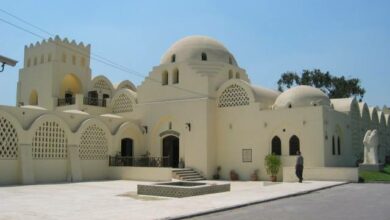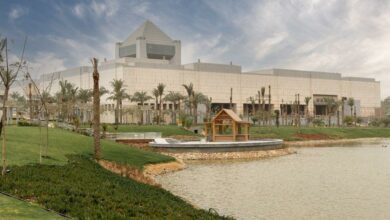
Since the National Museum of Egyptian Civilization, in Cairo’s El Fustat, was first announced in 1978, Egypt has seen one president assassinated and two overthrown. Suzanne Mubarak, then Egypt’s first lady, laid the first foundation stone in 2002. And yet it is still not open to the public.
The vast museum, which aims to capture Egyptian history from pre-history to the present day, has suffered delay after delay.
“This is a big project – for Egypt and the Middle East,” Dr. Mohamed Fawzy, director of the National Museum of Egyptian Civilization (NMEC), said. Asked if the project was maybe too big, Fawzy said he remained confident that the project would see completion soon. The museum director claimed the beleaguered 33-acre site could even start receiving visitors in six months’ time.
“That is my opinion, as well as Antiquities Minister Mohamed Ibrahim’s.”
On Monday, Ibrahim called for opening up the “entertainment area” of the museum site – consisting of a mall, cafeteria and parking lot – in an attempt to drum up profits to finish the rest of the project. Museum administrators hope to open the commercial end of the site in as little as three months’ time.
The commercial complex boasts a cafeteria, gift shop, cinema and an underground mall area which will house over 40 different shops. Builders are still milling around inside, plans still being looked over.
“All the buildings are finished,” Fawzy told Egypt Independent inside his plush on-site office. “We are just waiting for the landscaping, planting the trees, that sort of thing.” Drilling from somewhere outside accompanied the conversation.
From the front entrance, besides a busy main road linking downtown Cairo with the Giza Pyramids, the NMEC does not look far off completion. A slick marble patio leads up to the museum’s main buildings. Plots of sandy soil mark out places where trees will eventually be planted.
Behind the NMEC’s mall stands the museum itself. A glass pyramid surrounded by scaffolding tops the large construction. Fayrouz Selim , the site’s public relations chief, promises to show me the view of the Citadel and nearby Coptic Cairo next time I visit.
Inside, the scene is rather different. The main entrance to the museum proper is stacked full of scaffolding. Workmen are building a metallic gate to cordon off the under-construction museum hall from the shoppers and corporate guests expected to arrive in a few months.
Inside, architects have planned six “scenes” in separate rooms which together will tell Egypt’s history, but now it looks more like an industrial warehouse.
The thousands of artefacts which will be displayed in the museum when it opens, some of them already being held behind locked doors in an underground on-site storage facility, will tell the story of Egypt – from Pharaonic to modern times – in this space.
And yet the NMEC is still in need of $200 million to finish the job, Fawzy told Egypt Independent. A “soft opening,” which would open up some museum exhibits as well as the entertainment area to the public, would still cost half that.
That is exactly what museum sponsors, organizers and Antiquities Ministry officials are hoping to achieve in the next six months.
But that won’t be easy.
“We have a problem with funding,” Fawzy admits. “We are struggling to establish the museum because so few tourists are coming to Egypt now.”
The vast June 30 protests which led to the military-sponsored overthrow of Islamist President Mohamed Morsy on 3 July has hurt an already dwindling tourism industry in Egypt.
Violence following security forces’ dispersal of pro-Morsy sit-ins at Rabaa al-Adaweya and Giza’s al-Nahda Square has hampered a national tourism industry still reeling after the country’s 2011 revolution, which ousted former dictator Hosni Mubarak.
On Monday Egypt Air announced it would cut ticket prices by 20 percent in an attempt to attract tourists to Egypt, as well as to encourage Egyptians to sightsee more at home.
Mohamed Maqsoud, director of the Antiquity Ministry’s pharaonic department, said Egypt’s January 2011 revolution, often blamed for hampering Egypt’s tourism prospects, had worsened the hold-up at the NMEC.
Fawzy says the same.
“After the revolution, all work stopped at the museum, because of a lack of funding,” he told Egypt Independent.
Maqsoud added: “Efforts to open the museum completely are ongoing. [But] we must open the site step by step.”
“I think it’s a big mistake that the museum has not been opened,” he added. “This is one of the best projects Egypt has.”
“The site must open now.”
The ministry’s push to get the public inside will likely receive help from UNESCO, a long-term supporter of the NMEC project.
“UNESCO was requested to assist in a broad fundraising campaign,” an UNESCO spokeperson told Egypt Independent on Wednesday. “At this stage, we are working with the Ministry of Antiquities on the nature of that campaign.”
UNESCO has provided long-term collaboration for the museum – as well as its sister project, the Nubia Museum in Aswan – including technical support, consultancy and fundraising.
“There’s an ongoing dialogue between the Egyptian team and UNESCO that will be active until the official opening of the museum to the public,” the museum's press kit says.
And yet a series of launch dates – including one in June 2011 and another last year – have all passed and the museum’s gates are still closed.
When it does open, the National Museum of Egyptian Civilization will give visitors an in-depth overview of Egypt’s long and turbulent history.
Until then it stands as a symbol of the country’s struggling tourism industry and the effect of over two years of political unrest.




